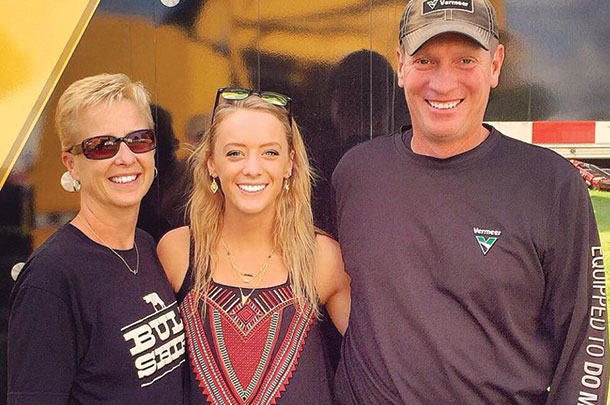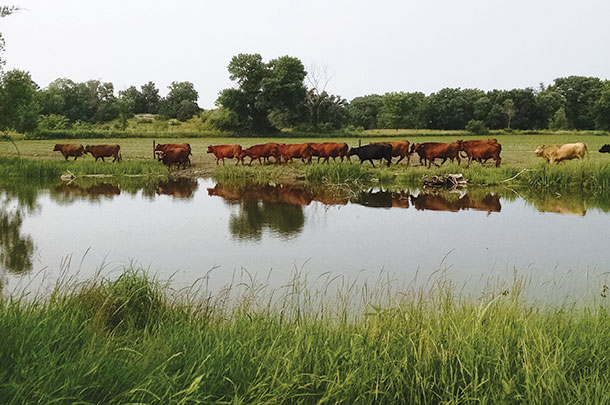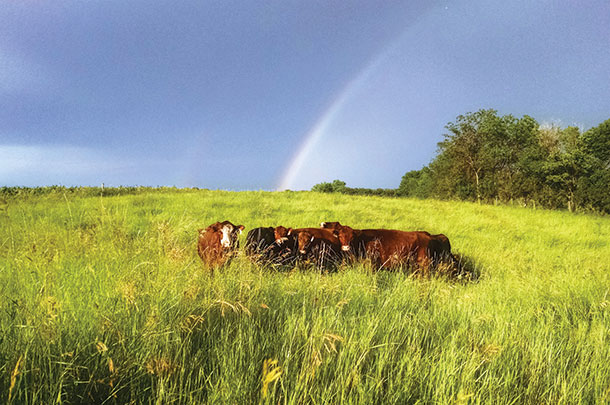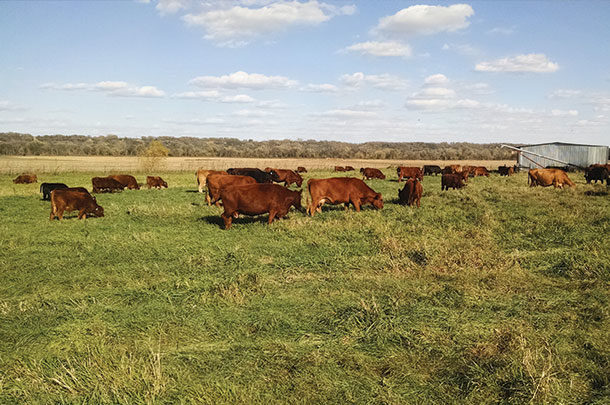it’s now essential business to stay in business. It may just be their saving grace as government entities hand landowners sometimes cumbersome restrictions and regulations.

Breitkreutz farms, ranches and runs a custom finish yard with his wife, Dawn, and daughter, Karlie. The Minnesota legislature dealt a challenging hand to landowners in its new Water Quality Buffer Initiative last year.
The “Buffer Law” aims to establish 110,000 acres of perennial vegetable cover adjacent to Minnesota’s waters by 2017, according to the state’s Department of Natural Resources common questions information sheet on the law. It requires perennial vegetation buffers of up to 50 feet along lakes, rivers, streams and ditches, and a minimum of a 16.5-foot buffer on public ditches.
For farmers along the Minnesota River, that could equal a significant amount of privately owned land coming out of production – without adequate compensation, Breitkreutz says.
But because of the evolution of their conservation practices on their diverse cow-calf and crop farm, Breitkreutz is hopeful they’ll be able to document and meet exemption standards to soften the blow. “If we can get these exemptions, we’ll be OK. But if we didn’t have cows or another use for that land after it’s in the buffer zone, we’d be in trouble,” he says.
Covered with native grass
When Breitkreutz attended a seminar in 2006 focused on soil health and alternative grazing practices, he was tuned into the potential for a lack of water more than the regulation of water. A presentation by a North Dakota rancher caught his attention.
“I saw what Gabe Brown was doing with intense grazing with 13 inches of rain, and we started figuring what we could do with our 24 to 36 inches in an average year,” Breitkreutz says, nodding to the owner of Brown’s Ranch (www.brownsranch.us) near Bismarck, North Dakota.
After four years of experimenting with and evolving into a short-duration, high-density mob grazing system of his own, Breitkreutz was able to completely eliminate the use of fertilizers on his pasture and reduce herbicide use to spot treatments. “Economically, that’s a big cut in input costs and the time and labor of application,” he says. But the change in output is the real gem.

Prior to developing their focused grazing management program, Breitkreutz identified three grass species in 450 acres of pasture. A decade later, a range specialist identified 26 to 28 species of grass on the same pastures, all which occurred naturally.
“By simply changing our grazing management, we’ve increased water infiltration, which means we get more grass, more diversity, on less rain,” Breitkreutz says. The additional species means both warm- and cool-season grasses are flourishing, lending to more reliable growth throughout all seasons, and varying root depth and structure adds to the soil’s biodiversity, too.
“We just don’t have standing water on outland anymore,” he says. “The water stays on the top of the hills like it’s supposed to. It filters into the ground evenly and holds there like it’s supposed to.”
With that, they’ve increased stocking capacities on their deeded land from 58 cows for three months to 120 cows for five to six months. The cattle graze in combination with a leased management plan on adjoining Minnesota Department of Natural Resources wildlife lands.
The partnership is a win-win for the farm and the public entity, Breitkreutz says, and another opportunity to exemplify the positive impact well-managed cattle grazing can have on the environment. He says, “We spent a lot of time getting to know our local land manager. He watched what we were doing on our farm, and they saw that’s how they wanted their land managed, too.”
The partnership lengthened their grazing season, allowing for longer rest periods on deeded grass to build diversity and regrowth. Breitkreutz says, “It takes time to see that change, especially in the grasses. But over time, it all adds up.”
Those changes became more obvious when the 2012 drought caught up with northern producers. “By then, we had increased holding capacity in our soil enough that we were still producing grass, even in the drought,” Breitkreutz says. “When we saw what we did in our pastures that year, how we increased production and reduced weather variability and were covered OK through the drought, that’s when we realized that’s what we wanted to be doing with our crops, too.”
Covered soil in the field
Again, Breitkreutz looked west to resources in North Dakota to garner ideas and learn from others’ experiences in non-conventional cropping systems. District conservationist Jay Fuhrer and his Burleigh County Soil Conservation District (bcscd.com) offered tools and ideas to get Breitkreutz’s traditional corn, wheat and soybean fields turned into fields where no-till, mulch-till and diverse cover-crop systems help the soil thrive and make sustainability more than a buzzword.
Breitkreutz started exploring no-till practices in 1998 in soybean fields and in the last two years – post-drought years – moved to no-till in wheat and corn, too.
Their first cover crops were single-species: turnips after a wheat cash crop. They planted just half the acreage with the turnip cover crop to experiment.

“We really didn’t think there was much that came out of that,” he says, until three years later when they planted those acres back to soybeans. “We had beans dying from nematode pressure, but only half of them. The other half was awesome. It took me a long time to figure out what was going on there,” Breitkreutz says.
Today, they’ve stopped planting nematode-resistant seeds thanks to their cover crop rotations. “Once we realized what it was doing for soil health, we switched to multiple species on the cover crops. It helps get the cover crops germinated, too – if one goes, it kick-starts the rest, it seems,” Breitkreutz says.
A more recent example includes putting wheat fields into an eight- to 10-seed cover crop mix right after a cash harvest in varying combinations of turnips, radishes, clover, rye, millet and more. They turn cattle out to graze from October to December. Breitkreutz figures it costs roughly $0.70 per cow per day to seed the cover crops for grazing, but they gain an average of 100 pounds per cow in 43 days.
They’re still experimenting and learning what cover crop combinations work best in their system, he says, but having livestock is a big benefit to recoup costs along the way.
“The cows can always benefit from the cover crops,” Breitkreutz says. “Even if we do something that may not feel like it’s having big impact on soil health, the cows will have a good feed source.”
Innovation doesn’t have to come at a high price, either, he points out. His record-keeping system is a handwritten notebook, they don’t use GPS or other in-cab technology, and the most important tools for success at Stoney Creek Farms are still a good electric fence and a side-by-side ATV to assist in pasture rotations. There is equipment available to purchase for interseeding cover crops, but Breitkreutz and a neighbor have worked up a plan to modify a cultivator themselves for the same purpose.
Looking back over the past decade, Breitkreutz says the no-till, intense grazing and cover cropping has covered his farm well ecologically and financially.
“There’s no doubt we’ve reduced purchased inputs using the cover crops and by focusing on soil health, and we’re definitely producing a bushel of corn for less than we did 10 years ago,” he says.
But perhaps the biggest long-term success comes in having the story to tell when they’re not on the farm. Knowing the implications of Minnesota’s new Buffer Law, Breitkreutz and another cattleman signed up to participate in the governor’s summit on water quality.
“There were about 1,000 people there, and they were all condemning agriculture. We sat there and listened to the assaults, then we explained what we actually do, how we take care of the land and the soil, and are actually improving it,” Breitkreutz says. “There was a complete turnaround in opinions in that room. And those are the opinions that are making the decisions and the laws that we have to deal with every day.” ![]()
Laura Nelson is a freelance writer based in Big Timber, Montana.
PHOTO 1: Prior to developing their focused grazing management program, Breitkreutz identified three grass species in 450 acres of pasture. After 10 years of a focused grazing management program, the grass species had naturally gone from three species to about 26 species.
PHOTO 2: Breitkreutz family photo.
PHOTO 3: By 2017, Minnesota’s “Buffer Law” requires perennial vegetation buffers of up to 50 feet along lakes, rivers, streams and ditches, and a minimum of a 16.5-foot buffer on public ditches.
PHOTO 4: By changing grazing management, water stays on the hills instead of running off, eliminating standing water on bottom lands. Photos courtesy of Grant Breitkreutz.










